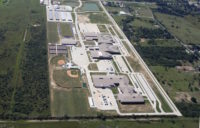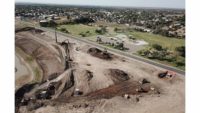Diversification isn’t a guaranteed safeguard against market swings in the construction industry. But for Houston-based Keystone Concrete Placement, ENR Texas & Louisiana’s Specialty Contractor of the Year, it’s proving to be a sound strategy.
Consider, for example, the relative cooling of big-budget projects in Keystone’s hometown market, largely the result of a prolonged slump in oil prices. By providing its services to education, health care and industrial projects, Keystone has enjoyed steady growth. For 2015, the firm posted regional revenue of $365 million, up $45 million from the previous year.
Keystone’s leadership credits the family-owned company’s recent growth to its willingness to venture into pretty much any sector or geographic market where it can be successful, which so far appears to be most of them.
“We’ve joked that diversifying hurts in good times,” says Mark Stewart, Keystone vice president. “But it was definitely a blessing in the recession, and we’re benefitting from it now.”
In addition to working on many of Houston’s mixed-use high-rises, such as the $125-million Kirby Collection and $29-million 1600 West Loop South, Keystone’s current Houston-area projects include the 350,000-sq-ft first phase of a high school campus to serve the Montgomery Independent School District; Methodist West Hospital’s 228,000-sq-ft, six-story patient tower; and a warehouse for Daikin Industries’ $417-million campus.
Strong economic activity in Austin and San Antonio, where Keystone maintains full-service offices, has provided a welcome geographic element to the company’s project mix. Keystone recently completed Dollar General Stores’ 2-million-sq-ft distribution center in San Antonio and will be involved with software-developer Oracle’s 560,000-sq-ft technology campus, which is being developed on a 25-acre site in Austin that was originally envisioned for The Waterfront mixed-use development.
Moving On Up
Following its founding in 1992, Keystone established itself as a turnkey specialist in concrete slabs, decks and tilt-up panels for the residential, commercial, industrial and institutional markets. The company began its move up—literally and figuratively—to multistory buildings by establishing a structural concrete division in 2000.
A turning point in the company’s diversification drive, according to Stewart, occurred about 10 years ago. Already well-established in petroleum-industry work and smaller commercial jobs, Keystone created opportunities to work on larger projects valued at $25 million or more.
“We proved ourselves by doing good work with high quality and finishing ahead of schedule,” he says. “That put us in a different realm.”
A contributing factor has certainly been Keystone’s ability to hire and retain talented people, a coveted asset for any construction firm. According to Tom Ward, the company’s business development director, Keystone benefits from a highly educated and trained team of estimators as well as the diverse experience of other key staff members.
Cultivating close partnerships with the company’s network of suppliers also has helped. “When our bid goes in, we like to think we know the job better than our competition,” Ward says.
And even if Keystone doesn’t win the job, Stewart adds, there’s no cause for alarm. “We consider our top 15 clients to be friends,” he says. “If we don’t get the job, we shake hands and move on to the next one.”
Those qualities also have positioned Keystone to respond to general contractors’ growing demand for early subcontractor involvement to provide constructibility reviews and other preconstruction analysis.
Scott Anderson, who heads Keystone’s structural division, says the firm is frequently contacted as much as 18 months before a project starts to provide insight on how the concrete tasks might unfold. “Contractors want to know what’s driving costs and how the method will fit into the overall schedule,” he explains.
And it’s not just the owners and contractors for large commercial projects that are interested in those insights. “We’re seeing the same thing for school projects, with general contractors and architects coming to us for value-engineering help,” Stewart says.
Problem-Solving Pros
Lohn Zylicz, vice president of D.E. Harvey Builders, Houston, appreciates Keystone’s thoroughness. “They’re not the kind of people who look at a set of plans, then throw out a number that may get you in trouble later on,” he says.
Zylicz has worked with Keystone on a variety of projects over the past decade, from low-rise buildings and garages to the 31-story Anadarko Hackett Tower in The Woodlands. But he says that Keystone’s ingenuity is perhaps best evidenced by a relatively small project for one of Houston’s major petroleum companies—a 33-ft-deep, 20-ft by 20-ft pit with 4-ft-thick walls used to test a variety of equipment.
“This was by no means an easy job,” Zylicz says, citing the structure’s unique setting, purpose and durability requirements. Keystone helped his team figure out the best way to construct it, Zylicz says, “because their guys are builders.”
So how has Keystone managed to keep this valued expertise in-house, especially in a hotly competitive construction market?
“We look for people who are comfortable with our way of doing business, people who we can train to do things the Keystone way,” Anderson says. “As new opportunities come along, they’re ready to step in and help lead that growth, following the same principles that have always guided us.”
“Employees see that we care for them and support causes that they care about.”
—Mark Stewart, Vice President, Keystone Concrete
Safety, an enduring focus from the company’s early work in the oil-and-gas industry, is a key priority. In addition to achieving an EMR of 0.5, last year Keystone completed a 2,500-sq-ft building dedicated exclusively to safety programs. It offers classrooms, video and role-playing instructional spaces and a fully stocked equipment room where appropriate safety gear is always available.
Keystone also invests heavily in training, encouraging its 1,600 employees to secure professional certifications in products, equipment and procedures. “We train and retrain our employees, no matter how long they’ve been with company,” Ward says.
Community involvement also fosters a stronger sense of engagement among Keystone employees. Beneficiaries of the company’s charitable support include the American Red Cross, the M.D. Anderson Cancer Center, the Wounded Warrior Project and the Be An Angel program for children.
“Employees see that we care for them and support causes that they care about,” says Stewart.
“They all share the same morals and work ethic,” Zylicz adds. “And they want to be a partner in our projects. We get to know everyone from the top people down to the project foreman.”
Have Skills, Will Travel
Keystone’s diversification strategy may not totally insulate the company from all market and industry variables, but Anderson is generally upbeat about what the immediate future holds. He is confident that the generally favorable business climate that has sustained Texas for the past several years, attracting headquarters operations for several leading corporations, will continue regardless of whatever 2017 brings.
“We’ve been in the recovery cycle for a while, so I almost half expect a minor slowdown,” Anderson says. “It may be seasonal or owners waiting to see the outcome of the election.”
Anderson adds that opportunities remain in the company’s home market of Houston, despite the absence of an imminent, sustained uptick in the oil market. The bigger challenge, he says, is one of perception. “People think things are worse than they are because oil companies are not spending capital,” he says, adding that however the market shakes out, Keystone will find a way to keep doing business.
“We may have to travel a bit,” he adds, “but we’ll find the work.”







Post a comment to this article
Report Abusive Comment